INDIAN ARMED FORCES CHIEFS ON OUR RELENTLESS AND FOCUSED PUBLISHING EFFORTS

The insightful articles, inspiring narrations and analytical perspectives presented by the Editorial Team, establish an alluring connect with the reader. My compliments and best wishes to SP Guide Publications.

"Over the past 60 years, the growth of SP Guide Publications has mirrored the rising stature of Indian Navy. Its well-researched and informative magazines on Defence and Aerospace sector have served to shape an educated opinion of our military personnel, policy makers and the public alike. I wish SP's Publication team continued success, fair winds and following seas in all future endeavour!"

Since, its inception in 1964, SP Guide Publications has consistently demonstrated commitment to high-quality journalism in the aerospace and defence sectors, earning a well-deserved reputation as Asia's largest media house in this domain. I wish SP Guide Publications continued success in its pursuit of excellence.
- Prime Minister Modi Visits Punjab’s Adampur Air Base, Interacts with Airmen after Successful ‘Operation Sindoor’; Stern Message to Pakistan
- The layered Air Defence systems that worked superbly, the key element of Operation Sindoor
- Operation Sindoor | Day 2 DGMOs Briefing
- Operation Sindoor: India strikes back with Precision and Purpose
- Operation Sindoor: Resolute yet Restrained
- India’s Operation Sindoor Sends a Clear Message to Terror and the World – ‘ZERO TOLERANCE’
- Japan and India set forth a defence cooperation consultancy framework, talks on tank and jet engines
- Terrorist Attack in Pahalgam in Kashmir: Unfolding a long surgical war against PAK
- Lt General Pratik Sharma takes over Command of Indian Army's Northern Command
Aero India 2025: A Global Convergence of Strategic Dialogues, Industry Leadership, and Bilateral Collaborations
The event featured crucial seminars, CEO roundtables, bilateral meetings, and government-industry interactions that can shape the future of defence cooperation and technological advancements.
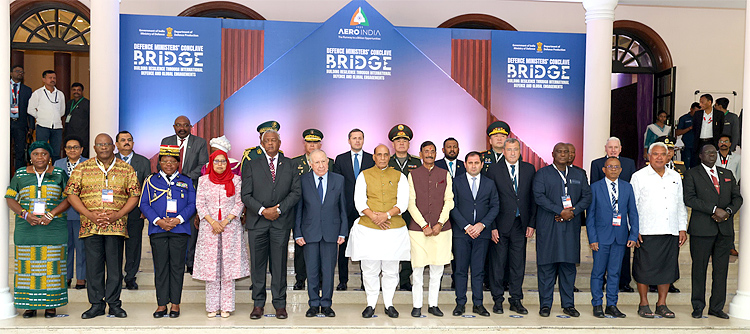
Aero India 2025 emerged as a premier platform for high-level engagements, fostering strategic discussions, industry collaborations, and landmark agreements in the global aerospace and defence ecosystem. With participation from top defence officials, policymakers, and industry leaders, the show facilitated key partnerships, joint ventures, and technology-sharing agreements. As nations and corporations engaged in dialogue to strengthen defence ties and explore emerging opportunities, Aero India 2025 reinforced its position as a pivotal hub for shaping the future of global aerospace and security collaborations.
Manthan 2025: Driving Defence Innovation
Manthan 2025, the premier defence innovation event, took place on February 12, 2025, in Bengaluru as part of Aero India 2025. Organised by the Innovations for Defence Excellence – Defence Innovation Organisation (iDEX-DIO) under the Department of Defence Production, the event brought together key stakeholders, including innovators, industry leaders, academia, investors, and government officials, to accelerate advancements in defence technology.
Manthan 2025 brought together key stakeholders, including innovators, industry leaders, academia, investors, and government officials, to accelerate advancements in defence technology.
A Roundtable Conference, chaired by Secretary (Defence Production) Sanjeev Kumar, underscored the need to enhance India's combat readiness through the adoption of cutting-edge technologies. He emphasised that integrating innovation into defence strategy would modernise the Armed Forces, bolster future preparedness, and maintain a technological edge. The conference saw participation from senior officials, industry leaders, and representatives from major defence PSUs, startups, and incubators such as IITs (Indian Institute of Technology) and IIMs (Indian Institute of Management).
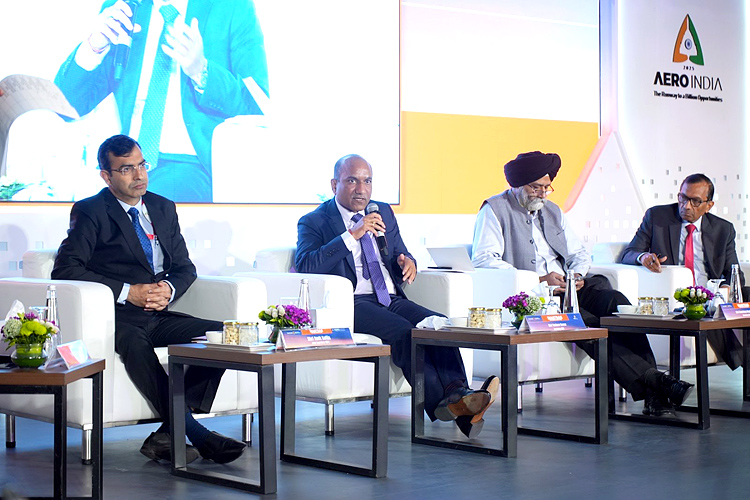
Discussions focused on supporting defence start-ups and MSMEs, fostering innovation, and strengthening strategic collaborations. iDEX-DIO's partnerships with leading investors and banks were highlighted as crucial for accelerating defence innovation and easing operational challenges. Manthan 2025 reflected the rapid progress of iDEX and the transformative role of start-ups in India's defence sector, reinforcing the self-reliance vision of the Ministry of Defence as India moves towards Viksit Bharat by 2047.
CEOs Roundtable: A Global Defence Convergence
The CEOs Roundtable, held on February 10, 2025, during the opening day of Aero India 2025, witnessed unprecedented participation from 116 global executives. Defence Minister Rajnath Singh presided over the event, which served as a platform for major announcements on investments, collaborations, and the establishment of development centers and Centres of Excellence in India.
A Roundtable Conference, chaired by Secretary (Defence Production) underscored the need to enhance India's combat readiness through the adoption of cutting-edge technologies.
Notable announcements included Ultra Maritime and Bharat Dynamics Limited's contract for co-producing US-specification defence equipment, Bharat Forge's initiative to manufacture landing gear for commercial aircraft entirely within India, and a co-production partnership between Safran (France) and Bharat Electronics Limited for the Hammer missile.
Fifty-eight foreign OEMs (Original Equipment Manufacturer), including Airbus, Lockheed Martin, Mitsubishi, and Thales, along with Indian defence manufacturers such as Bharat Forge, Adani Defence & Aerospace, and Mahindra Defence Systems, participated in the discussions. The Defence Minister urged global OEMs to leverage India's expanding defence ecosystem and collaborate on solutions to counter emerging geopolitical challenges.
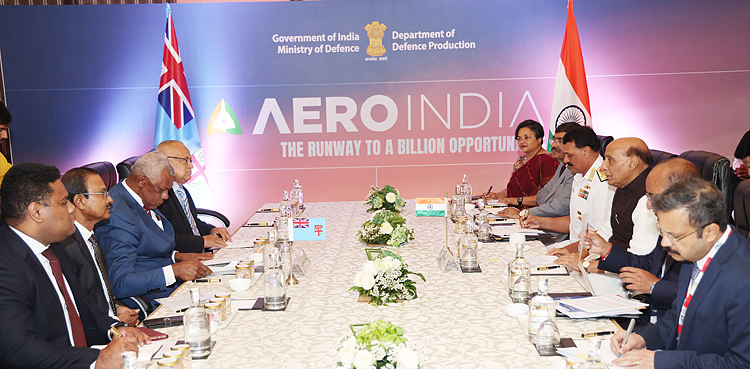
Themed 'Enabling Defence Cooperation through Global Engagement (EDGE),' the Roundtable emphasised business-centric technology development, joint ventures, industry-led capacity building, and technology transfer.
In his address, Rajnath Singh highlighted India's strides in self-reliance, citing policies such as 75 per cent FDI through the Automatic Route for new defence licensees, 46 foreign investment-approved joint ventures, and significant MoUs for industrial development in Defence Industrial Corridors. He noted that India's defence exports had surged 31 times in the past decade, reflecting the country's emergence as a global defence manufacturing hub.
Presided over by the Defence Minister, the CEOs Roundtable witnessed participation from 116 global executives. Fifty-eight foreign OEMs, along with Indian defence manufacturers, participated in the discussions.
Senior defence officials, including Chief of Defence Staff General Anil Chauhan, and service chiefs, attended the Roundtable. Global OEMs outlined plans for joint ventures, R&D centers, MRO facilities, and technology partnerships with Indian firms, reinforcing India's position as a major player in the global defence sector.
Strengthening Global Defence Ties at Aero India 2025
Aero India 2025 in Bengaluru served as a crucial platform for bilateral engagements, with the Defence Minister Rajnath Singh and the Minister of State for Defence Sanjay Seth holding a series of high-level meetings to reinforce India's defence cooperation with global partners.
On February 9, Rajnath Singh met with the Defence Ministers of Fiji and South Sudan. India and Fiji agreed to institutionalise their Joint Working Group on Defence Cooperation, building upon their 2017 MoU. With South Sudan, discussions focused on expediting an MoU to enhance bilateral defence relations.
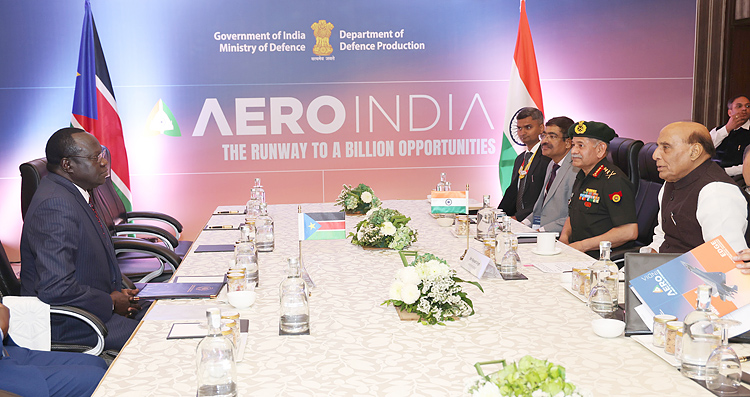
February 10 saw extensive meetings with defence officials from Tanzania, Algeria, Zambia, Italy, the UK, and Lesotho. Talks with Tanzania focused on counter-terrorism and naval cooperation, including shipbuilding. Discussions with Algeria aimed at strengthening ties in diverse defence sectors. With Zambia, India emphasised capacity building and UN peacekeeping operations. The meeting with Italy reviewed India's growing indigenous defence capabilities, while the UK reaffirmed collaboration in maintaining a rules-based order in the Indo-Pacific. Lesotho explored potential defence exports and deeper cooperation.
On February 11, Indian Defence Minister engaged with the Defence Ministers of Armenia, Malawi, and Madagascar. India and Armenia reinforced their growing defence collaboration, emphasising military training and joint ventures. Malawi and India discussed finalising a Defence Cooperation MoU, while talks with Madagascar focused on maritime security in the Indian Ocean Region.
At the Defence Ministers' Conclave, addressing over 162 delegates from 81 countries, including 15 Defence Ministers, Rajnath Singh highlighted the evolving global security landscape, marked by hybrid warfare, disruptive technologies, and blurred distinctions between internal and external security.
February 12 featured strategic engagements with Zimbabwe, Yemen, Ethiopia, Gambia, and Gabon. India and Zimbabwe signed an MoU to enhance training and capacity building, including cooperation in military medicine. Ethiopia and India formalised their defence cooperation through an MoU, highlighting military training and industry collaboration. Discussions with Yemen underscored military training and defence partnership. Gambia and Gabon reaffirmed their commitment to strengthening bilateral defence cooperation, focusing on capability enhancement and defence industry partnerships.
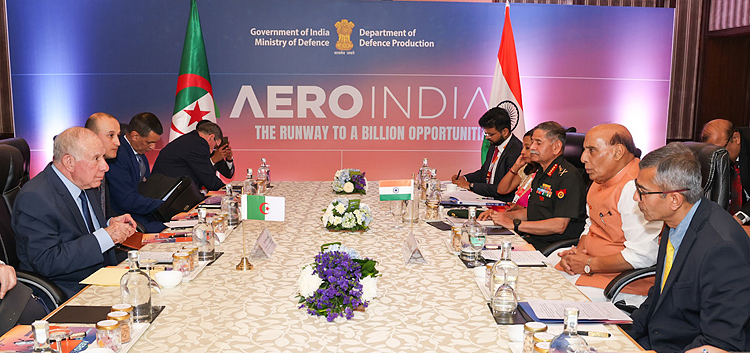
Defence Minister's Conclave
At the Defence Ministers' Conclave during the 15th Aero India in Bengaluru on February 11, 2025, Defence Minister Rajnath Singh urged global partners to collaborate with India in co-developing and co-producing advanced defence systems. Addressing over 162 delegates from 81 countries, including 15 Defence Ministers, Singh highlighted the evolving global security landscape, marked by hybrid warfare, disruptive technologies, and blurred distinctions between internal and external security.
Singh emphasised that artificial intelligence, quantum technologies, hypersonic weapons, and directed energy systems were reshaping warfare, necessitating a reassessment of defence strategies. He reaffirmed India's commitment to strengthening its defence capabilities under Prime Minister Narendra Modi, promoting investment-friendly policies, and positioning India as a global hub for R&D and defence innovation.
Singh emphasised that artificial intelligence, quantum technologies, hypersonic weapons, and directed energy systems were reshaping warfare, necessitating a reassessment of defence strategies.
The conclave's BRIDGE initiative underscored the importance of transforming dialogue into actionable partnerships. Delegates lauded India's role in peacekeeping, supply chain resilience, and technology transfers. Discussions covered shared security concerns, including terrorism, cybercrime, illegal fishing, and drug trafficking, with nations committing to collective action under the theme of "One Earth, One Family, One Future."
Concluding the event, Minister of State for Defence Sanjay Seth expressed gratitude to the attendees and reaffirmed India's commitment to deepening international defence cooperation. The conclave served as a platform for fostering strategic alliances, investment in joint ventures, and advancements in AI, space technology, and maritime security.
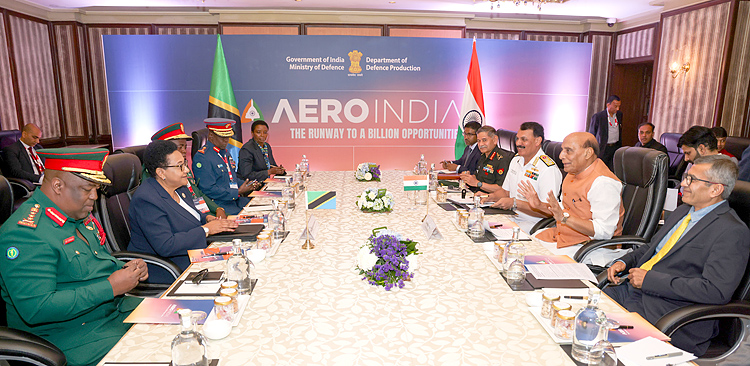
DRDO Showcases Indigenous Defence Innovations
At the India Pavilion, Defence Research and Development Organisation (DRDO) unveiled the Advanced Medium Combat Aircraft (AMCA), a 5.5-generation stealth fighter featuring cutting-edge technology. The pavilion highlighted India's Make-in-India initiative, showcasing indigenous defence capabilities from missiles to advanced propulsion systems.
Defence Minister's conclave served as a platform for fostering strategic alliances, investment in joint ventures, and advancements in AI, space technology, and maritime security.
The DRDO indoor pavilion featured over 330 products across 14 technology zones, including advanced materials, avionics, unmanned aerial systems, next-gen sensors, and aerospace propulsion technology. The outdoor segment demonstrated real-world applications, with highlights like the upgraded Dornier aircraft featuring enhanced avionics and fuel efficiency. Other displays included the Naval Anti-Ship Missile - Medium Range, the Kaveri Derivative Aero Engine (without afterburner), and cutting-edge UAV and radar systems developed under the Technology Development Fund (TDF) scheme. DRDO also displayed a new 155mm ramjet projectile for Bharat Forge Limited's (BFL's) 155 mm/52 calibre Advanced Towed Artillery Gun System (ATAGS) at the show.
Global Investors meet
Rajnath Singh, speaking at the Global Investors Summit in Karnataka, highlighted India's political stability, vast market potential, and robust legal framework as key strengths for investors. He emphasised Karnataka's role in shaping India's technological advancements and expressed confidence that Bengaluru would pioneer India's first Foundational AI Model, just as it did with software technology.
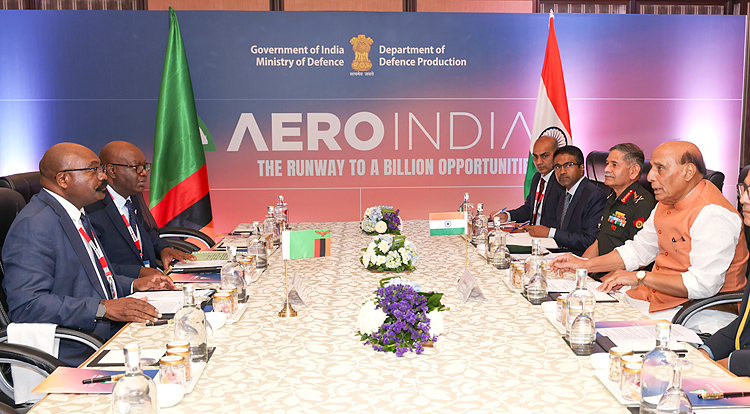
He assured investors of a business-friendly environment under the current government, citing streamlined clearance processes, tax reliefs, and reduced red tape as measures to boost economic growth. Rajnath Singh emphasised that investing in Karnataka offers businesses long-term opportunities within a collaborative ecosystem, fostering both individual and national economic prosperity. He invited investors to leverage these favorable conditions, emphasising that India now rolls out a "red carpet" for investment rather than imposing bureaucratic hurdles.
Strategic Dialogues at Aero India 2025
The Aero India 2025 also hosted the seminar 'Navachar Utkrishtam Bhavisyam' (Innovation is the Path to a Better Future) on February 11, 2025. Organised by the Indian Air Force (IAF), the event aimed to foster collaboration between the defence sector and indigenous industries. Minister of State for Defence Sanjay Seth, highlighting the IAF's role in supporting domestic defence manufacturing, emphasised that innovation is key to a secure future. He noted that strengthening indigenous capabilities ensures operational superiority and long-term maintenance support.
During the seminar, it was underscored that Micro, Small, and Medium Enterprises (MSMEs) and startups are crucial drivers of defence innovation. Sanjay Seth called for their active participation in equipping the Armed Forces with advanced technologies to address evolving security challenges. Additionally, the seminar featured a panel discussion on the role of Indian industry in fostering indigenous solutions for futuristic defence technologies.
At the India Pavilion, DRDO unveiled the Advanced Medium Combat Aircraft (AMCA), a 5.5-generation stealth fighter featuring cutting-edge technology.
At the 15th Aero India 2025, the seminar 'DRDO-Industry Synergy towards Viksit Bharat: Make in India, Make for the World' focused on strengthening collaboration between the Defence Research and Development Organisation (DRDO), industry, and research institutions. Sanjay Seth emphasised the necessity of self-reliance in defence for national security, aligning with the vision of 'Viksit Bharat 2047.'
During this event, the Defence Minister launched the 'VAYU VITT' digital portal, facilitating seamless supply orders, certification, and payments between the IAF and Hindustan Aeronautics Limited (HAL), enhancing efficiency and digitisation in defence procurement. Additionally, he introduced the 'DRDO-Industry Synergy' compendium, outlining niche opportunities for innovation in aerospace technology, and released an updated policy document, 'DRDO-Industry Synergy towards Viksit Bharat: Make in India, Make for the World.' The event also featured the signing of a tripartite Memorandum of Understanding (MoU) between the Centre for Military Airworthiness and Certification, Defence Institute of Advanced Technology, and the Aeronautical Society of India to streamline technology transfers to industries.
Another highlight was the Indian Navy's seminar, 'Atmanirbhar Indian Naval Aviation – 2047 and its Associated Ecosystem.' Minister of State for Defence Sanjay Seth underscored the role of a self-reliant defence industry in securing the region, particularly given India's strategic position in the Indian Ocean.
Highlighting recent global conflicts, he emphasised the importance of a robust domestic defence industry in strengthening national security. The seminar also saw the launch of the Indian Naval Aviation roadmap for 2047, a guiding document for advancing indigenous defence R&D.
With over 60 warships under construction in Indian shipyards and 39 indigenous ships and submarines commissioned recently, the Indian Navy continues to lead the 'Aatmanirbhar Bharat' initiative, aiming for full self-reliance by 2047. The Indian Ocean's geostrategic significance underscores the need for indigenous defence capabilities, ensuring national security and regional stability.
The Indian Space Association also organised a seminar on Mission DefSpace. Many seminars were parallelly held during the first three days of Aero India bringing together decision makers and initiating important deliberations.
A tripartite MoU was also signed among the Centre for Military Airworthiness and Certification, the Defence Institute of Advanced Technology, and the Aeronautical Society of India, enabling industry access to certification processes and expertise.
The event reinforced the crucial role of Indian industry, particularly MSMEs and startups, in the country's journey towards technological self-sufficiency and a strong indigenous defence ecosystem. Presentations highlighted the impact of innovative defence solutions on national security and India's strategic role in the Indian Ocean region.





